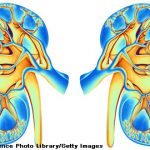NEW YORK (Reuters Health)—There are insufficient data to make evidence-based decisions regarding the benefits and harms of osteoporosis medications in patients with chronic kidney disease (CKD), according to a systematic review and meta-analysis.
“We found low to moderate evidence for the effects of some but not all of the medications, and the evidence was limited in the populations studied and by issues with study reporting and conduct,” says Dr. Karen A. Robinson from Johns Hopkins University’s Evidence-based Practice Center, in Baltimore, Md.
“In making decisions about these treatments, clinicians should weigh the potential benefits and risks of treatment, taking patient preferences into account,” she tells Reuters Health by email.
Dr. Robinson’s team reviewed the benefits and harms of osteoporosis medications (bisphosphonates, teriparatide, raloxifene and denosumab) vs. placebo, usual care or active control in terms of bone mineral density (BMD), fractures and safety in patients with CKD.
“This manuscript reports part of a larger project that provided the systematic review of evidence used by the Kidney Disease: Improving Global Outcomes (KDIGO) guideline committee to develop and update their recommendations,” Dr. Robinson says. “This research expands on other systematic reviews by including patients with all stages of chronic kidney disease, other osteoporosis medications, and a detailed assessment of safety outcomes.”
The 13 studies included in their review involved a total of 9,850 patients with CKD.
Based on six studies, there was moderate strength of evidence (SOE) that bisphosphonates may slow loss of lumbar spine BMD after kidney transplantation, but their effects on femoral neck BMD might not be consistent. The effects of bisphosphonates on BMD of other patients with CKD were less clear.
There was low SOE that raloxifene might not increase BMD more than placebo in three studies lasting up to 36 months, the researchers report in Annals of Internal Medicine, online April 11.1
Only one study with high risk of bias compared teriparatide with placebo, leaving the authors unable to draw a conclusion about its effects on BMD. For similar reasons, they were unable to draw a conclusion about the effects on BMD of denosumab versus placebo or ibandronate versus risedronate.
Studies of fractures were equally problematic. High risks of bias and low or very low SOE resulted in inconclusive outcomes, with one exception: raloxifene might be better than placebo at preventing vertebral fractures.
Safety studies were generally inadequate, with none that reported on serious cardiovascular events, renal-related adverse events or musculoskeletal pain finding statistically significant differences between the treatment and control groups. None of the trials reported on hyperphosphatemia, hypophosphatemia, hypersensitivity reactions or osteonecrosis of the jaw.
“More research is needed, particularly among patients with chronic kidney disease stages 3 to 5, to determine the safety and effectiveness of osteoporosis medications in patients with CKD,” Dr. Robinson concludes.
“Studies should be adequately powered to show a reduction in the risk for fractures and should have sufficient follow-up (>=3 years),” the researchers note. “Future research should also provide details about trial methods, should specify a priori how outcomes will be measured and reported, and should report on adverse events and safety.”
Reference
- Wilson LM, Rebholz CM, Jirru E, et al. Benefits and harms of osteoporosis medications in patients with chronic kidney disease: A systematic review and meta-analysis. Ann Intern Med. 2017 Apr 11. doi: 10.7326/M16-2752. [Epub ahead of print]

